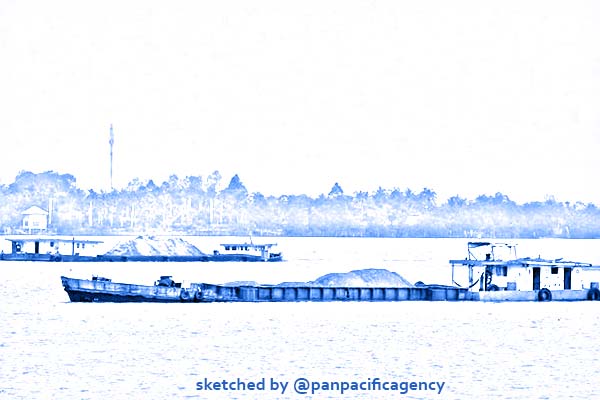[Analytics] Chinese support gives Laos an edge over powerful neighbor Vietnam

Mekong river. Photo by the VoA. Sketched by the Pan Pacific Agency.
A Mekong River hydropower dam scheduled to open this month worries Vietnam because the country sits just downriver from it and would be threatened by lower water flows. Officials in Hanoi aren’t wildly protesting to the dam’s host country, Laos, however, because Vietnam knows Laos has support from their much larger neighbor, China, reported the Voice of America, according to the LaosNews.net.
Vietnamese leaders instead are approaching Laos cautiously about the dam, out of fear the tiny landlocked country would seek more of that help from Beijing, Southeast Asia scholars say. Vietnam struggles to get along with China and resents Chinese expansion in other parts of Asia.
The new fear in Hanoi shows it can no longer treat Laos as a client state as it’s used to doing, those experts say.
“Vietnam is worried that Laos is just doing a little bit too much to dam up the Mekong,” said Murray Hiebert, senior associate of the Southeast Asia Program at the think tank Center for Strategic and International Studies in Washington. “But Vietnam, although they have talked quietly to the Lao, it has not chosen the nuclear option to carry on very publicly and condemn Laos.”
Laos once on back foot
Vietnam historically had an edge over Laos. In the 19th century, monarchs in Laos “paid tribute to the Vietnamese court” in a relationship modeled on Vietnam’s own subservient stance toward China at the time, U.S. research institution GlobalSecurity.org says.
Laos had become a Vietnamese “client state” by the 1980s after Vietnam helped foster the Lao communist party, it says. During the Vietnam War of the 1960s, thousands of North Vietnamese troops were based in Laos to maintain the crucial Ho Chi Minh Trail communications network. Today, Lao leaders still study in schools in Hanoi for communist officials.
Since the 1980s, Vietnam has surged ahead economically on manufacturing investment, while Laos depends largely on farming. About 23% of the 6.9 million Lao people live in poverty compared to 6% of Vietnam’s 95 million people, the Asian Development Bank says.
However, the wealthier China has helped build otherwise hard-to-get infrastructure to Laos, most notably a high-speed rail line and special economic zones. Some of the projects fall under China’s 6-year-old Belt and Road Initiative aimed at driving up Sino-foreign trade around Eurasia. Chinese funding also built some of the country’s roads and bridges.
The Lao hydroelectric project, Xayaburi Dam, is widely expected to reduce water, fish and sediment to about 50 million people downriver, many in Vietnam.
Sino-Vietnamese friction
China and Vietnam have chafed for centuries over territory. They now dispute resource-rich tracts of the South China Sea. The two countries are cordial on paper, but regular maritime sovereignty flaps stop relations from growing tighter.
The government in Beijing gives Laos and Cambodia economic help to ensure their political support on regional issues including some where Vietnam stands on the other side, said Stephen Nagy, senior associate politics and international studies professor at International Christian University in Tokyo.
In Cambodia, a relatively poor country with a pro-Beijing political outlook since the 1960s, China has invested between $400 million to $700 million per year since 2010, the Chinese Ministry of Commerce says. As of September 2017, China had invested a total of about $6.3 billion in Laos, ministry data show.
“China can provide a little bit of economic assistance and ensure that those two states don’t, for example, agree with ASEAN consensus or when China and Vietnam’s interests are colliding, the Chinese can positively influence Laos and Cambodia,” Nagy said. ASEAN is the 10-member Association of Southeast Asian Nations.
Vietnam relies more on Japan, Singapore, South Korea and Taiwan for investment. Japanese funding helped build some of Vietnam’s signature infrastructure projects.
Regional politics
Vietnam is watching the boom in Chinese investment in Cambodia to understand what might happen if China adds to its holdings in Laos, said Trung Nguyen, international relations dean at Ho Chi Minh University of Social Sciences and Humanities.
Cambodia normally sides with China on ASEAN issues including maritime policies that touch on the Sino-Vietnamese sovereignty dispute.
“I think that’s what the Vietnamese government is afraid of, that scenario, and so that’s the reason why it’s so like a push-and-pull game between the Vietnamese government and the Chinese government to win over Laos,” Nguyen said.
Vietnam is showing it hopes to keep working with Laos on its own terms.
On Wednesday this week, youth unions from the two sides discussed adding activities for children along their border as a way of fostering future cooperation.
And last week prime ministers from the two countries agreed to keep up formal exchanges in what the official Viet Nam News called “a more streamlined, effective and substantive manner, with emphasis on the sharing of experience and seeking solutions to difficulties and obstacles.”